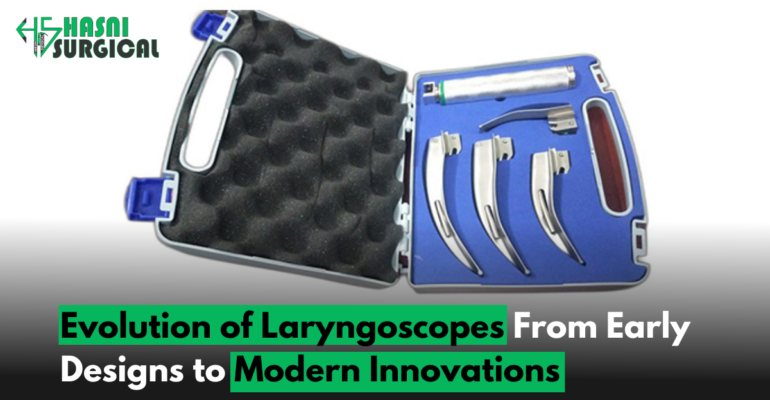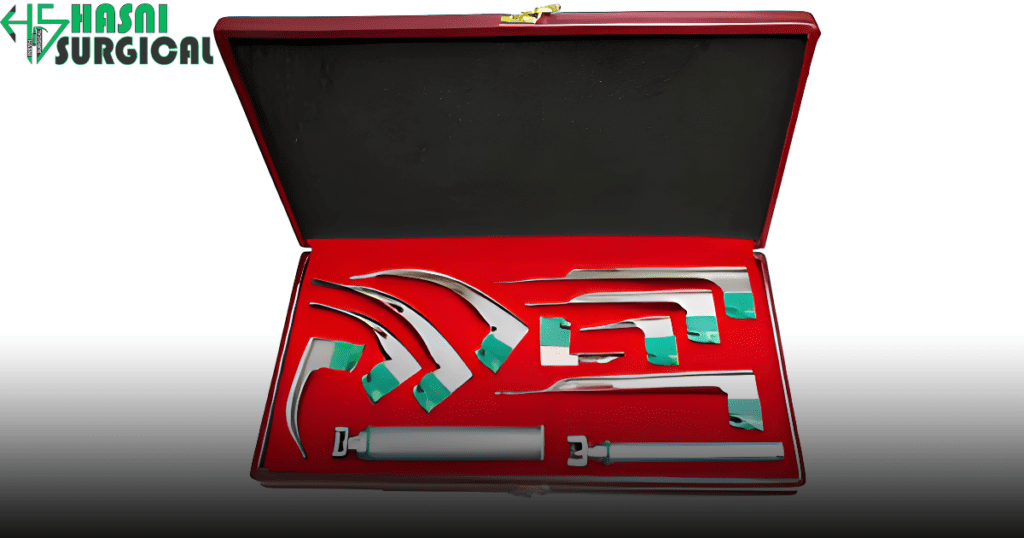Understanding the Evolution of Laryngoscope Instruments: From Early Designs to Modern Innovations
March 15, 2024 2024-11-21 7:02Understanding the Evolution of Laryngoscope Instruments: From Early Designs to Modern Innovations

Understanding the Evolution of Laryngoscope Instruments: From Early Designs to Modern Innovations
Introduction:
Laryngoscope Instruments
Laryngoscopy, the examination of the larynx, is vital in medical diagnostics and airway management. Laryngoscopy procedures have evolved from basic tools to advanced devices, enhancing clinical standards. This evolution highlights the history of medical innovation and its impact on patient care and safety. You can find these instruments at HasniSurgical.com.
Throughout history, physicians and surgeons have grappled with the challenge of visualizing the delicate structures of the larynx. Early pioneers designed instruments for clinicians to view the throat with clarity, laying the groundwork for advancements in laryngoscopy.
This blog post explores the evolution of laryngoscopy procedures, from Manuel García’s innovations to modern fiber optics and video technology, showcasing advancements in patient care.
Also read: laryngoscopy procedure Advancements: Rehab Impact
Join us as we explore the history of laryngoscopy procedure development, celebrating the triumphs and challenges that have shaped airway management in medicine. This journey deepens our appreciation for past strides and reveals the potential for future advancements in clinical practice.
Early Designs:
In the early days of laryngoscopy, physicians struggled to visualize the larynx due to limited tools. In 1855, Manuel García, a Spanish singing teacher, created a rudimentary laryngoscopy procedure using a small mirror on a long handle to indirectly view the larynx. While innovative, García’s design had notable limitations.
The indirect nature of García’s laryngoscopy procedure meant that the view of the larynx was often obscured or distorted, making accurate diagnosis and treatment challenging. Additionally, the reliance on external light sources for illumination resulted in inconsistent lighting conditions, further complicating the procedure. Despite these drawbacks, García’s invention represented an important first step in the quest to improve visualization of the larynx and paved the way for future developments in laryngoscopy.
Building upon García’s pioneering work, subsequent inventors and physicians sought to refine laryngoscope designs to achieve better outcomes. Throughout the 19th and early 20th centuries, various iterations of laryngoscopy procedures were introduced, incorporating modifications such as larger mirrors, adjustable angles, and improved handles for better maneuverability. However, these early instruments still fell short in terms of providing a clear and unobstructed view of the larynx, limiting their utility in clinical practice.
Early laryngoscope designs, despite their limitations, highlighted the need for better visualization and illumination, paving the way for innovations like fiber optics and video laryngoscopy, which revolutionized airway management.
The Turning Point: Macintosh and Miller Blades
In the mid-20th century, the Macintosh and Miller blades revolutionized laryngoscopy and set the stage for modern laryngoscopy procedures.
Sir Robert Macintosh, a renowned anesthesiologist, introduced the Macintosh blade in the 1940s. Motivated by the need for better endotracheal intubation tools, Macintosh designed a curved blade with a smooth tip. Its unique shape gently navigates the pharyngeal structures, lifting the epiglottis and revealing the glottic opening. The Macintosh blade became the gold standard in direct laryngoscopy for decades due to its simplicity, reliability, and ergonomic design.
Around the same time, Dr. Robert Miller, an otolaryngologist, introduced the Miller blade as an alternative design for laryngoscopy. Unlike the curved Macintosh blade, the Miller blade featured a straight, elongated profile with a flatter tip.
The introduction of the Macintosh and Miller blades revolutionized airway management, enhancing clinicians’ control, efficiency, and success in intubation. These blades became indispensable tools in anesthesia, emergency medicine, critical care, and otolaryngology, transforming the landscape of laryngoscopy worldwide.
Beyond their immediate impact on clinical practice, the Macintosh and Miller blades spurred further innovation and refinement in laryngoscopy procedure design. Later laryngoscopy procedure enhanced the original designs with improved lighting, ergonomic handles, and interchangeable blades.
Today, the Macintosh and Miller blades are essential in laryngoscopy procedure kits, representing innovation and collaboration in medicine. Their lasting impact continues to drive progress in airway management and inspire medical professionals globally.
Fiber Optic Technology:
The introduction of fiber optic technology in the late 20th century transformed laryngoscopy procedure instruments. By incorporating fiber optic bundles into laryngoscope blades, medical professionals gained improved illumination, clarity, and flexibility, leading to safer and more precise airway management.
The introduction of fiber optic laryngoscopy procedure addressed several key limitations of traditional direct laryngoscopy techniques. Clinicians struggled with poor larynx illumination due to traditional laryngoscopy procedure blades relying on external light sources. Fiber optic technology addressed this issue by incorporating a bundle of flexible, transparent fibers within the laryngoscope blade. These fibers carry light from a halogen or xenon lamp to the blade tip for uniform airway illumination.
In addition to improved illumination, fiber-optic laryngoscopy procedure instruments offered enhanced visualization capabilities. The optical fibers provided clear, high-resolution images of the larynx, which was useful when traditional laryngoscopy was obstructed.
Fiber optic technology improved laryngoscopy procedure blades’ flexibility and maneuverability, enabling precise airway navigation with less patient discomfort. The slim fiber optic bundles eased oral cavity insertion, making them ideal for delicate intubations and head and neck surgeries.
The introduction of fiber-optic laryngoscopes revolutionized airway management, allowing for more confident and efficient laryngoscopy. Fiber-optic technology is quickly setting the standard for intubations and spurring innovations like video laryngoscopy procedure.
In conclusion, fiber optic technology revolutionized laryngoscope instruments by overcoming longstanding limitations associated with traditional direct laryngoscopy techniques. Fiber optic laryngoscopy procedure enhance airway management by offering superior illumination, visualization, and maneuverability, improving safety and success rates. As medical technology advances, fiber optics continue to drive innovation and improve patient care in various clinical settings.
Expanding on the topic of video laryngoscopy:
Video laryngoscopy advances airway management by using advanced imaging to improve larynx visualization during intubation. Video laryngoscopy provides a clear, magnified view on a monitor, unlike traditional laryngoscopy, which relies on direct sight.
Improved Visualization: One key benefit of video laryngoscopy is its superior view of the larynx and vocal cords. The camera in the laryngoscopy procedure blade provides high-resolution images, allowing for clearer visualization, even in challenging cases. This helps clinicians place the endotracheal tube more accurately, reducing the risk of complications like esophageal intubation or tissue trauma.
Enhanced Teaching and Training: Video laryngoscopy facilitates educational opportunities by enabling real-time viewing of intubation procedures. Trainees and novice practitioners can better grasp airway management techniques and anatomical landmarks, improving their skills. Recorded videos also facilitate review, feedback, and ongoing quality improvement, promoting continuous learning and skill enhancement among healthcare providers.
Accessibility in Challenging Cases: Patients with anatomical variations, limited neck mobility, or cervical spine injuries present unique challenges during intubation. Video laryngoscopy offers a solution by providing an alternative approach that may be more suitable for such cases. Visualizing the airway on a monitor helps clinicians navigate obstacles and improve intubation success, even in complex cases.
Reduced Intubation-related Complications: Video laryngoscopy improves visualization and tube placement, leading to fewer intubation-related complications. Studies show it reduces esophageal intubation, dental trauma, and hypoxemia compared to traditional methods. This improved safety profile translates into better patient outcomes and decreased morbidity associated with airway management procedures.
Adaptability and Versatility: Video laryngoscopes come in various designs and configurations to suit different clinical needs and preferences. Some models have angulated blades for improved visualization, while others offer interchangeable blades for different anatomies. Portable and handheld video laryngoscopy procedure now facilitate quick and efficient intubation in emergency and pre-hospital settings.
In conclusion, video laryngoscopy is a game-changer in airway management, providing better visualization, improved teaching, and increased patient safety. As technology advances, future innovations will further enhance its effectiveness and accessibility, benefiting patients and healthcare providers globally.
Future Directions:
As technology advances rapidly, the future of laryngoscope instruments promises significant innovation and refinement. Here are some exciting possibilities and directions that could shape the evolution of these vital medical tools:
Augmented Reality Integration: Augmented reality (AR) is set to transform airway management by integrating with laryngoscopy procedure. AR overlays real-time anatomical data onto the clinician’s view, improving spatial awareness and precision during intubation. This technology provides dynamic visual guidance and anatomical landmarks, potentially streamlining the intubation process and reducing complications.
AI-Assisted Guidance: AI algorithms can analyze patient data to offer personalized recommendations during intubation. AI-powered laryngoscopes, using machine learning, can suggest optimal blade selection, positioning, and techniques, improving success rates, especially in difficult cases.
Miniaturization and Portability: Advances in microelectronics and miniaturization techniques may lead to the development of compact and portable laryngoscopy procedure instruments. Miniaturized devices offer flexibility and convenience, especially in pre-hospital and remote settings with limited space. Portable laryngoscopes with wireless and cloud features enable real-time specialist consultations and EHR integration, improving care and decision-making.
Multimodal Imaging Modalities: Using infrared, ultrasound, and near-infrared spectroscopy during laryngoscopy could enhance airway, vasculature, and tissue oxygenation assessment. Multimodal laryngoscopes may improve diagnostic accuracy and patient safety, allowing clinicians to customize their approach for better outcomes.
Patient-centric Design: Future laryngoscopy procedure instruments may prioritize patient comfort, safety, and satisfaction through innovative design features and materials. Ergonomic blades, soft materials, and non-invasive methods minimize discomfort and trauma during intubation, particularly for pediatric and geriatric patients. Patient-centric laryngoscopes could include feedback mechanisms to continuously improve device performance based on real-world use.
Remote Monitoring and Telemedicine Integration: As telemedicine grows, laryngoscope instruments may support virtual consultations with integrated sensors and connectivity. This would enable real-time sharing of laryngeal images and vital signs with remote providers, improving access to specialized care.
Conclusion:
The future of laryngoscopy procedure instruments looks bright with innovations driven by advanced technologies and patient-centered design. Emerging trends like augmented reality, AI, miniaturization, multimodal imaging, and telemedicine are set to improve airway management and patient care. As these technologies develop, laryngoscopy is poised to significantly advance medical practices and patient outcomes.


